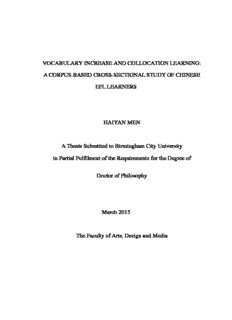
VOCABULARY INCREASE AND COLLOCATION LEARNING PDF
Preview VOCABULARY INCREASE AND COLLOCATION LEARNING
VOCABULARY INCREASE AND COLLOCATION LEARNING: ACORPUS-BASED CROSS-SECTIONALSTUDYOF CHINESE EFLLEARNERS HAIYAN MEN AThesis Submitted to Birmingham City University in Partial Fulfilment of the Requirements for the Degree of Doctor of Philosophy March 2015 The Faculty ofArts, Design and Media Acknowledgements I would like to extend my sincere gratitude to all those who have directed me into the field of Englishlinguistics andprovided me withsomuch guidance andencouragement throughout the period ofmydoctoralstudy. Firstandforemost,mydeepestgratitudegoestomysupervisor,ProfessorRichardIngham,whose rigorous academic training, thought-provoking guidance, and invaluable spur in various viewpoints havealwaysbeentreasuresformeinthewritingprocessandbeyond.Iwouldalsoliketothankhimfor his endless patience in revisingthe draft chapters, and myconference abstracts. Apart frombeing my supervisor, he is also a wonderful mentor. I have also benefited much from him for his humour and uniquewaysofthinking.Thankstohisvaluableinstructionandwarmsupport,Iamabletopursuethis doctoralstudyandaccomplishitintime. Iamverymuchindebtedtotwoothersupervisors,Dr.UrsulaLutzkyandProf.AntoinetteRenouf, fortheirvaluablecommentsandassistance,andfortheirconscientiousproofreadingofthedrafts. IamparticularlygratefultoProf.YangHuizhongfornotonlyhislivelyandstimulatinginstruction throughoutmyMAstudy,butalsoforhiscontinuousmonitoringandconstantcriticalcommentsonmy doctoral thesis. I also owe my debt to him for his constant care of both my academic study and life overseas. At an institutional level my thanks are due to Shanghai Sanda University for providing financial supportforthisdoctoralstudy,andforprovidingfundsformetoattendconferencesofthisfield. Finally,mygratitudeisreservedformyparentsandfriends.Specialthanksaregiventomyfiancé andnowhusband,Mr.WangShuaiforhisunselfishhelpandunfailingsupport. Thoughimmensehelphasbeenreceivedfromthosewhosecontributionshavebeenacknowledged above,ItakesoleresponsibilityforanyerrorsandfailingsIhavenotbeenabletocorrect. I Abstract Collocation learning has long been recognised as aproblematicdomainforeven high-level learners and acknowledged to lag far behind acquisition of other SLA aspects. This thesis explores the role of vocabulary growth in the learning of L2 collocations. It addresses the relationship between vocabulary increase and L2 collocation learning, aiming to identify whether increasing lexemes in a syn(onym)set (Fellbaum,1998)isthemainfactorresponsible.Acorpus-basedcross-sectionalstudywasundertakenon Chinese EFL learners’writtenproductionof threetypes of collocations: verb+ nouncollocations (the main research target), adjective + noun and noun + noun collocations. Lexical verbs in verb + noun collocations were classified into synsets and analyses were performed on collocations within these synsets. ItfindsalaginL2learners’verb+nouncollocationalknowledgewith risingproficiency.Thislag in collocational knowledge was found to be associated with an increase in lexical verbs learnt at higher levels. Collocationerrorswereseldommadewheretherewasnoincreaseinverbsynsets.However,for synsets in which there was a verb increase, collocation errors involving new verbs were significantly morelikelythanerrorswitholdverbs.Theoccurrenceofcollocationerrorsbecameincreasinglylimitedto synsetswithaverbincreaseaslearnersproceededtomoreadvancedlevels.Analternativeexplanationwas attempted to see if newly acquired nouns were also a factor responsible for the collocation lag. Results showed that in the majority of new nouns produced by higher levels of learners, collocations were target-like,andthepercentagesofnewnounsinerroneousverb+nouncollocationsremainedconstantat bothhigherlevels. Incontrast,itfindsanimprovementinL2learners’knowledgeofadjective+nounandnoun+noun collocations. The thesis attempted to account for such differing performance from the perspective of vocabulary growth within synsets. The decreasing synonym density of verbs, adjectives and nouns may account for the relatively poorer performance on verb + noun collocations, and better performance on adjective + noun and noun + noun collocations. These findings are discussed with a view to a clearer understandingoftheprocessofsecondlanguagecollocationlearning,andtopedagogicalimplications. II Abbreviations Corpora: BNC BritishNationalCorpus CLEC ChineseLearnerEnglishCorpus ICLE InternationalCorpusofLearnerEnglish Dictionaries: Bilingualdictionaries: NCCED NewCenturyChinese-EnglishDictionary OALECD Oxford Advanced Learner’s English-Chinese Dictionary (7th Edition) Englishdictionaries: BBI The BBI Combinatory Dictionary of English: Your Guide to CollocationsandGrammar(3rdEdition) EVCA EnglishVerbClassesandAlternations OCDSE Oxford Collocations Dictionary for Students of English (2nd Edition) ODSA OxfordDictionaryofSynonymsandAntonyms COBUILD CollinsCOBUILDEnglishDictionary(2ndEdition) Chinesedictionaries: CCD ContemporaryChineseDictionary(5thEdition) Otherabbreviations: AN adjective+noun DeLexVN delexicalverb+noun EFL Englishasaforeignlanguage ELT Englishlanguageteaching ESL Englishasasecondlanguage FL foreignlanguage FLT foreignlanguageteaching L1 firstlanguage/mothertongue L2 secondlanguage/foreign/targetlanguage LexVN lexicalverb+noun NN noun+noun NNSs non-nativespeakers NSs nativespeakers POS PartofSpeech SL secondlanguage SLA secondlanguageacquisition VN verb+noun III Contents ListofTables....................................................................................................................................VIII ListofFigures......................................................................................................................................X Chapter1:Introduction.........................................................................................................................1 1.0Generalbackground................................................................................................................1 1.1Aimsofthethesis....................................................................................................................3 1.2Theshapeofthethesis............................................................................................................7 Chapter2:Literaturereview(1):Thenotionofcollocation.................................................................9 2.0Introduction.............................................................................................................................9 2.1Theimportanceofcollocation.................................................................................................9 2.1.1Thepervasivenessofphraseologicaltendency.............................................................9 2.1.2TheimportanceofcollocationforL2learners...........................................................12 2.1.3Summary....................................................................................................................13 2.2Thenotionofcollocation.......................................................................................................14 2.2.1Collocationpreviouslyapproached............................................................................14 2.2.1.1Thepsychologicalapproach............................................................................15 2.2.1.2TheFirthianapproach......................................................................................17 2.2.1.3Thephraseologicalapproach...........................................................................21 2.2.2Collocationdefinedinthisstudy................................................................................27 2.2.3Collocationsclassifiedinthisstudy...........................................................................30 2.2.4Summary....................................................................................................................33 Chapter3:Literaturereview(2):CollocationstudiesinsecondlanguagelearnerEnglish................34 3.0Introduction...........................................................................................................................34 3.1MethodologiesadoptedinL2collocationstudies.................................................................34 3.1.1Elicitationdata-basedcollocationstudies..................................................................35 3.1.2Spontaneousdata-basedcollocationstudies...............................................................39 3.2PreviousfindingsfromL2collocationresearch....................................................................42 3.2.1Formsofcollocationdeficiency:overuse,underuseandmisuse...............................43 3.2.1.1Overuseandunderuse......................................................................................43 3.2.1.2Collocationmisuse..........................................................................................45 3.2.2Theroleoflearners’L1..............................................................................................47 3.2.2.1L1influenceintermsofL1-inducedinappropriatecollocationuses..............47 3.2.2.2TheroleofL1intermsofL1andL2collocation(non)congruence...............48 3.2.3Collocationlag...........................................................................................................53 3.3Summary...............................................................................................................................56 Chapter4:Researchdesign.................................................................................................................57 4.0Introduction...........................................................................................................................57 4.1Researchpurposeandquestions............................................................................................57 4.2Theselectionofverb+noun,adjective+nounandnoun+nouncollocations....................59 4.3Thelearnercorpus–CLEC...................................................................................................60 IV 4.4Collocationdictionariesforreference...................................................................................63 4.5Thereferencecorpus–BNC.................................................................................................64 4.6Softwareforretrievalandanalysis........................................................................................65 4.7Procedure...............................................................................................................................66 4.7.1Taggingandreliabilitycheck.....................................................................................66 4.7.1.1POSTagging....................................................................................................66 4.7.1.2Reliabilitycheck..............................................................................................67 4.7.2Investigationofverb+nouncollocations..................................................................68 4.7.3Investigationofadjective+nounandnoun+nouncollocations...............................73 4.8Summary...............................................................................................................................74 Chapter5:Verbincreaseandtheproductionofverb+nouncollocations(1)....................................75 5.0Introduction...........................................................................................................................75 5.1Overallanalyses(1):generalpatternsofVNcollocationsproduced byL2learners............75 5.1.1Overalltokensofcollocations....................................................................................75 5.1.2Overalltypesofcollocationsandcollocationfrequencydistribution........................77 5.1.3Collocationmisuses....................................................................................................82 5.1.4SynopsisofOverallanalyses(1)................................................................................85 5.2Overallanalyses(2):between-groupcomparisonsofdelexicalandlexicalVNcollocations86 5.2.1Between-groupcomparisonsofwell-formedDeLexVNandLexVNcollocations....88 5.2.2Between-groupcomparisonsoferroneousDeLexVNandLexVNcollocations........90 5.2.3SynopsisofOverallanalyses(2)................................................................................92 5.3Overallanalyses(3):verbgrowthandcollocationerrors......................................................93 5.4Synopsisoftheoverallanalysesofverb+nouncollocations...............................................95 Chapter6:Verbincreaseandtheproductionofverb+nouncollocations(2)....................................98 6.0Introduction...........................................................................................................................98 6.1Detailedanalyses–verbincreaseandcollocationuses........................................................98 6.1.1AnalysisofVNcollocationswithinsynsetsidentifiedattheST2andST6levels...101 6.1.2 Analysis of VN collocations within synsets identified at the ST2, ST5 and ST6 levels ...........................................................................................................................................106 6.2Synopsisofdetailedanalysesofverbincreaseandcollocationuses...................................111 6.3Analternativeexplanation:newnounsandcollocationuses..............................................113 Chapter7:L2learners’performanceonadjective+nounandnoun+nouncollocations................122 7.0Introduction.........................................................................................................................122 7.1Analysesofadjective+nouncollocations..........................................................................122 7.2Analysesofnoun+nouncollocations.................................................................................124 7.3Synopsisoftheanalysesofadjective+nounandnoun+nouncollocations......................128 Chapter 8: Comparison and interpretation of learners’performance on the three types of collocations ...........................................................................................................................................................129 8.0Introduction.........................................................................................................................129 8.1Collocationerrorsinthethreetypesofcollocations...........................................................129 8.2Vocabularygrowthandcollocationerrors...........................................................................131 V 8.3Synsetsandcollocationproduction.....................................................................................133 8.4Synopsisofthefindingsinthischapter...............................................................................138 Chapter9:TheroleofL1incollocationlearning.............................................................................139 9.0Introduction.........................................................................................................................139 9.1Thenotionofcongruence....................................................................................................140 9.2 Within-group comparison of well-formed and erroneous congruent and non-congruent VN collocations................................................................................................................................143 9.3 Between-group comparison of the well-formed and erroneous congruent and non-congruent VNcollocations.........................................................................................................................148 9.4Within-groupcomparisonofpositiveandnegativeL1influencewithVNandANcollocations ...................................................................................................................................................153 9.5Synopsisoffindingsinthischapter.....................................................................................156 Chapter10:Summaryandconclusions.............................................................................................158 10.1Summary...........................................................................................................................158 10.2Implications.......................................................................................................................163 10.2.1Theoreticalimplications.........................................................................................163 10.2.1.1ImplicationsforlexicalorganisationintheL2mentallexicon...................163 10.2.1.2Implicationsforcross-linguisticinfluenceinL2collocationlearning........165 10.2.2Pedagogicalimplications........................................................................................169 10.2.2.1Acquisitionofverbsemantics.....................................................................169 10.2.2.2Consciousness-raising.................................................................................172 10.3Limitationsandwaysforward...........................................................................................174 References.........................................................................................................................................177 Appendices AppendixIErroneousVNcollocationsproducedbythethreelevelsoflearners(types).........190 AppendixIIWell-formedanderroneousVNcollocationsinthe16synsets(ST2)..................191 AppendixIIIWell-formedanderroneousVNcollocationsinthe16synsets(ST6).................193 Appendix IV Frequencies of well-formed and erroneous VN collocation types in the 16 synsets (ST2andST6)...................................................................................................................197 AppendixVWell-formedanderroneousVNcollocationsinthe16synsets(ST5)..................198 Appendix VI Frequencies of well-formed and erroneous VN collocation types in the 16 synsets (ST2,ST5andST6)...........................................................................................................200 AppendixVIIAdjectivescategoriesintheST2andST6ANcollocationdatabases................201 Appendix VIII Well-formed and erroneous congruent and non-congruent collocations in the ST6 (types)................................................................................................................................202 Appendix IX Well-formed congruent and non-congruent VN collocations in the ST2 and ST6 (types)................................................................................................................................203 AppendixXErroneouscongruentandnon-congruentVNcollocationsintheST2andST6(types) ...........................................................................................................................................204 Appendix XI Positive and negative transfer between VN and AN collocations in the ST2 (types) ...........................................................................................................................................205 VI AppendixXIIPositive andnegative transfer betweenVN andAN collocations in theST6(types) ...........................................................................................................................................206 VII List of Tables Table2-1ClassificationsofEnglishwordcombinations............................................................21 Table2-2Howarth’scategorisationofcollocationsintofivelevelsofrestrictedness.................25 Table2-3Previousdefinitionsofcollocationsandcriteriaadopted............................................28 Table2-4Aframeworkfordemarcatingcollocations.................................................................30 Table2-5ClassificationsoflexicalcollocationsbyBensonetal.(2010)...................................32 Table4-1Abriefsummaryofthedesignofthestudy.................................................................74 Table5-1VNcollocationsdividedintothreefrequencygroups.................................................78 Table5-2Well-formedanderroneousVNcollocationsinthethreelevelsoflearners(types)...83 Table5-3Well-formedanderroneousVNcollocationsinthethreelevelsoflearners(tokens).87 Table5-4Well-formedVNcollocationsproducedbythethreelevelsoflearners(tokens)........89 Table5-5Well-formedVNcollocationsproducedbythethreelevelsoflearners(types)..........90 Table5-6ErroneousVNcollocationsproducedbythethreelevelsoflearners(tokens)............91 Table5-7Growthratesoflemmatisedverbs,nounsandLexVNcollocations...........................94 Table6-1SynsetsoccurringbothinST2andST6VNcollocationdatabases..........................100 Table 6-2 Frequency of well-formed and erroneous VN collocations in the 16 verb synsets (ST2 andST6)............................................................................................................................102 Table6-3VNcollocationproductioninvolvingoldandnewverbsattheST6level................104 Table6-4CollocationusesinvolvingoldverbsandnewverbsattheST6level......................105 Table6-5VerbsynsetsclassifiedfromST2,ST5andST6VNcollocationdatabases..............107 Table6-6Well-formedanderroneousVNcollocationsinthe16verbsynsets(ST2,ST5andST6) ...........................................................................................................................................108 Table6-7ProportionsofVNcollocationerrorsassociatedwiththe12synsetswithaverbincrease ...........................................................................................................................................109 Table 6-8 New nouns and old nouns in ST6 VN collocations (new nouns as compared with ST2) ...........................................................................................................................................115 Table 6-9 18 new nouns in ST6 erroneous VN collocations and their verb collocates (new nouns ascomparedwithST2)......................................................................................................116 Table6-10NewandoldnounsinST6VNcollocations(newnounsascomparedwithST5)..119 Table6-11NewandoldnounsinST5VNcollocations(newnounsascomparedwithST2)..119 Table6-12NewnounsinST6VNerroneouscollocations andtheirverbcollocates (new nounsas comparedwithST5)..........................................................................................................120 Table6-13NewnounsinST5VNerroneouscollocations andtheirverbcollocates (new nounsas comparedwithST2)..........................................................................................................120 Table7-1ANcollocationsproducedbyST2andST6learners(tokens)..................................123 Table7-2ANcollocationsproducedbyST2andST6learners(types)....................................123 Table7-3Noun+nouncolligationerrorsproducedbyST2andST6learners.........................125 Table7-4Colligationandnon-colligationNNerrorsintheST2andST6levels(tokens).......126 Table7-5Colligationandnon-colligationNNerrorsintheST2andST6levels(types).........126 VIII Table7-6Noun+nouncollocationsintheST2andST6levels(tokens).................................127 Table7-7Noun+nouncollocationsintheST2andST6levels(types)...................................127 Table8-1ErrorratiosofVN,AN,andNNcollocationsproducedbyST2andST6learners...129 Table8-2Growthratesofadjectives,nounsandcollocationerrors..........................................131 Table8-3Numbersofwords,synsetsandsensesinWordNet..................................................134 Table8-4Selectedwordsinthelearnerdatabasesandthenumberofsynonyms.....................137 Table9-1Well-formedanderroneouscongruentandnon-congruentcollocationsintheST2(tokens) ...........................................................................................................................................144 Table9-2Well-formedanderroneouscongruentandnon-congruentcollocationsintheST2(types) ...........................................................................................................................................144 Table 9-3 Well-formed and erroneous congruent and non-congruent collocations in the ST6 (tokens)..............................................................................................................................145 Table9-4Erroneouscongruentcollocationsattributableto‘differentiation’............................147 Table9-5Erroneouscongruentcollocationsattributableto‘coalescing’.................................147 Table 9-6 Well-formed congruent and non-congruent VN collocations in ST2 and ST6 (tokens) ...........................................................................................................................................148 Table9-7Erroneouscongruentandnon-congruentVNcollocationsinST2andST6(tokens)149 Table9-8Transferandnon-transferVNcollocationerrorsproducedbyST2andST6learners154 Table9-9PositiveandnegativetransferinVNandANcollocationsintheST2(tokens)........155 Table9-10PositiveandnegativetransferinVNandANcollocationsintheST6(tokens)......155 IX
Description: